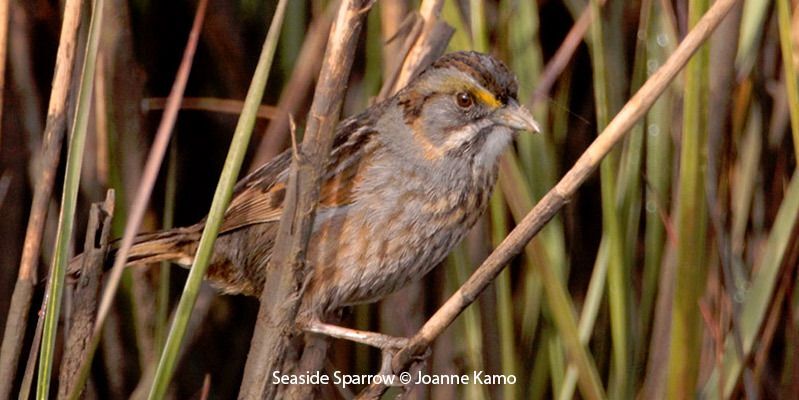Birds and Wind Power
Resources
-
Protecting birds from poorly sited wind turbines, on the American Bird Conservancy website.
-
Houston Audubon is a member of the Coastal Habitat Alliance.
What is the Price of Texas Wind Energy?
by Winnie Burkett, December, 2006
Recent studies show that if global warming continues there will be a high impact on humans and wildlife. We know that finding clean sources of energy is a critical issue. Today Texas produces more wind energy than any other state, but this may be a dubious distinction because we do not know the wildlife and habitat costs of that wind energy. We do know that at sites in other states there have been problems with birds and bats being killed, but why is there no information about the impact of wind energy on wildlife in Texas? Currently in Texas there are no regulations requiring the evaluation of the impact of wind energy facilities on wildlife or wildlife habitat.
We tend to think that the only impact of a wind energy facility is mortality due to collision with turbine blades, but the potential impact of the facility can be much larger than that. Habitat fragmentation and degradation is a big concern when wind farms are built in sensitive habitats or when the facility is constructed so that the infrastructure changes drainage patterns. Avoidance is another concern as some species will not use habitat near wind turbines. Studies in other states have shown that grouse and prairie-chickens are particularly sensitive to towers and turbines, but their impact on most other species is yet to be studied.
Regulation of construction of wind generating facilities varies from state to state and community to community. Some states have mandatory wind siting statutes; others have voluntary guidelines for siting; in some states regulation is done by local governments with siting rules and voluntary checklists of resources that need to be protected. Most statutes, rules and guidelines include pre-construction studies to determine possible wildlife and habitat impacts of the proposed wind energy facility and post-construction monitoring to ensure that no threatened or endangered species or their habitats are affected by the facility.
In Texas, if a developer wants to put in a wind farm, they "should" check with Texas Parks and Wildlife (TPW) to see if the location has sensitive habitat and/or endangered and threatened species. Some wind energy companies doing business in Texas are very concerned about their impact on habitat and wildlife. They check with TPW and do their own pre-construction environmental studies of the sites. Unfortunately this is not true of all companies. At this time there is also no published information about post construction monitoring in Texas and there is probably very little being done. Should people who care about birds be concerned? We are!! Most Texas wind energy facilities are in West Texas and the Panhandle, regions which are arid and where wildlife is often scarce, but there is undoubtedly some impact.
However recent developments indicate that wind energy companies want to move to the coast, where there are good winds during the day when energy demand is high. We know of six wind farms proposed for the Texas Coast, four onshore and two offshore. All six are proposed for areas known for large numbers of birds and for places that may be used by migrating and resident bats. The potential for catastrophic mortality in these areas is great! There is concern among environmentalists, TPW and some wind companies about the possible wildlife and habitat impacts. Recently Houston Audubon and several other environmental organizations have formed the Texas Wind and Wildlife Alliance (TWWA) to evaluate these issues. Houston Audubon representatives and other members of TWWA have been meeting with other stakeholders to draft guidelines for siting of wind energy facilities in Texas. Most wind energy companies are dependent on investors to fund their projects; they want to be able to tell investors that they have used state and/or local guidelines for siting their facilities. Two companies, PPM and Horizon, are currently conducting bird surveys on coastal sites where they are contemplating building wind farms. Unfortunately not all wind companies are going through this process, and it is very frightening to contemplate what the costs might be to migrating raptors, Brown Pelicans, Neotropic migrants brought low by adverse weather, and other species that use the Texas Coast.
So what can we do? It is important to slow global warming so we want to use clean energy if possible, and if you have signed up with a company that provides you with wind energy, ask where the wind energy facilities are located. Find out if they do post construction mortality surveys, and tell them that it is important for us to know the cost of Texas wind energy. I will warn you that the wind energy representatives will have no answers and will most likely try to engage you in a conversation about the problems of more traditional electric generation, but we must keep up the questioning. We need to know the cost of Texas wind energy. You can also support Houston Audubon’s efforts to get guidelines written for the siting of wind farms in Texas. We need clean energy but we also need to make sure the cost to Texas wildlife and habitat is affordable.


